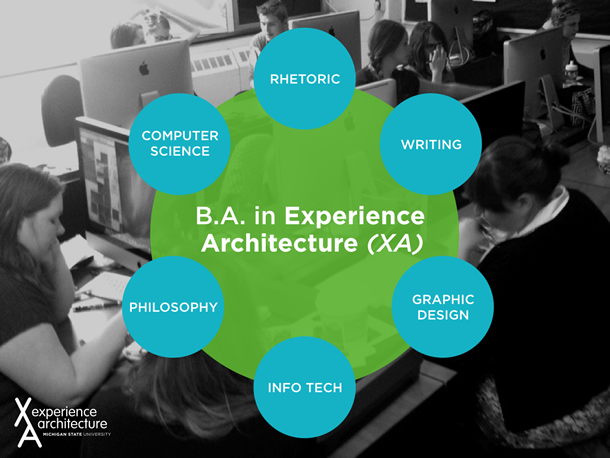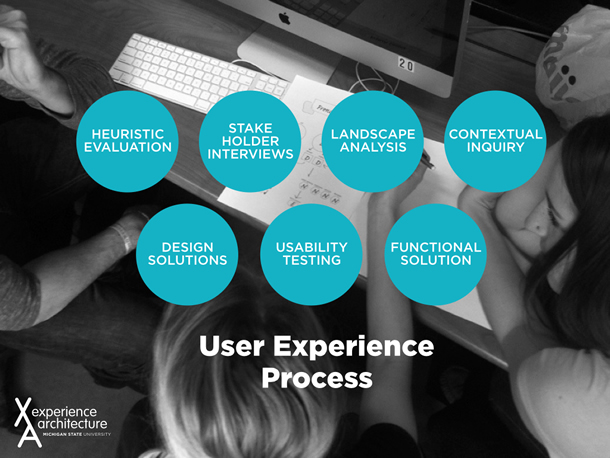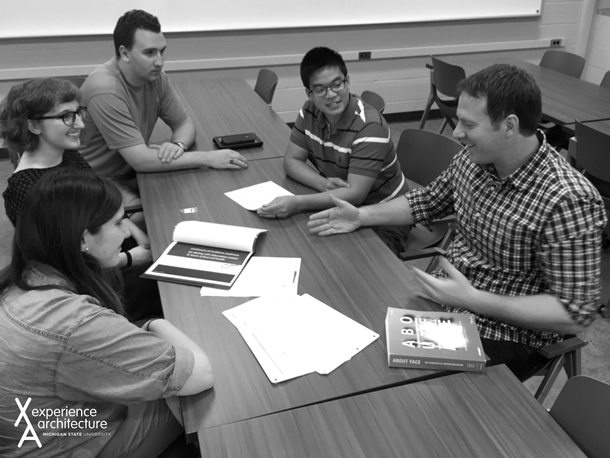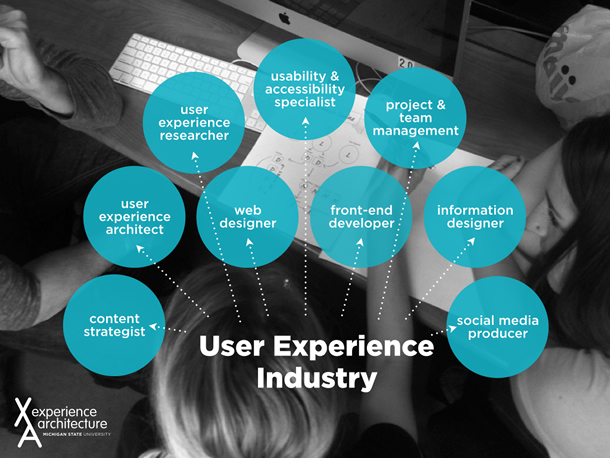The Experience Architecture (XA) program at Michigan State University is a cutting-edge, interdisciplinary major in the Humanities focused on user experience. Through the exploration and building of products, services, and policies of digital and physical objects, students are trained as user experience architects, usability specialists, user researchers, information architects, interaction designers, content strategists, project managers, and developers of digital products, services, and policies.
Our curriculum is firmly rooted in rhetoric and design while drawing on courses from across the university in computer science and information technology. With the goal of teaching students to be architects of digital experiences, we see the XA major as a way to positively influence the ways in which we have traditionally built products and services by focusing on human experience first instead of technology. This article will talk about how we developed this program and how we position this program within the Humanities, challenging older academic boundaries while creating new spaces for innovation.
Core Goals of Our Program
The Experience Architecture program seeks to help students learn to become user experience practitioners. This major is about creating new forms of knowledge, rethinking undergraduate studies, and producing Humanities-trained students who are leading product development and design. The program is deeply interdisciplinary, drawing on courses from across the College and University. Figure 1 illustrates the different fields we draw on for our coursework.

With backgrounds in industry, the faculty in this program are very focused on creating courses that emphasize a mixture of theory and practice. All the XA affiliated faculty have a stake in this program as researchers and practitioners. This article describes how we work with industry partners to develop a curriculum that aims to solve real world problems while rooted firmly in the perspective of architecting experiences to promote human-centered products, services, and processes. We will briefly describe the courses and interdisciplinary strengths of this program.
The study and practice of rhetoric is a major component of our XA program. Focused on how best to address audiences and work with participants, our courses on rhetoric and writing seek to provide an education where XA students learn to be better user experience researchers and practitioners. These courses include an emphasis on culture, visual rhetoric, content strategy, and technical writing, as well as help guide our curriculum in information architecture and information design.
Along with courses in rhetoric, the XA program offers courses related to the study of design. Emphasis is on understanding the core concepts of graphic design practice and the methods of creative problem solving used in design thinking. Students learn the skills necessary to create new ideas and carry them forward either as an independent or collaborative contributor to human-centered problems. Courses establish methods of critical thinking, processes to understand people and the systems through which they interact, and the theories, concepts, and tools central to the development of communication systems.
Why the Humanities?
Why the humanities as the foundation for a degree in XA? There are three reasons we have found to be compelling:
- Killer Robots. But seriously…a basis in human values is something that we cannot afford to look beyond when it comes to preparing the next generation of professionals for technology-focused careers. STEM curricula are notoriously jammed with requirements that impose practical limits on studying ethics, history, and yes, even dystopian novels.
- UX professionals are increasingly working in human-centered sectors of the economy such as healthcare and education. In these areas, a broader understanding of cultural values and a focus on communication skills can be as valuable to a product development effort as programming. Moreover, these skills are harder to train for on the job and nearly impossible to outsource effectively.
- UX professionals need to be excellent communicators—writers and speakers—in order to become leaders. In the short term, the appeal of our XA graduates to employers is their ability to face clients and lead teams, delivering clear and compelling messages and helping their co-workers become better in the process. Our students are technically savvy but they are also well-prepared (and eager) to deliver a pitch or write a white paper.
Training Future User Experience Architects
All of our classes are taught by faculty from across the College of Arts and Letters, as well as faculty in our Computer Science programs. This section will briefly describe the following courses, in terms of their goals and outcomes: User Research, Information Architecture, Project Management, and Prototyping. All of our courses are created with the help of our industry partners and our course content is reviewed and updated each time we teach these classes to ensure that they meet industry standards and address recent innovations. Together all the courses balance theory with practice, combining hands-on learning of the research, theory, and practice of creating compelling experiences. Figure 2 illustrates the process we are emphasizing in our pedagogy.

Maintaining and sustaining our industry partnerships is an important component of our program. We have created a position called an experience architect in residence (or XA in residence for short).
Keith Instone currently holds this position and we are grateful for his investment of time, energy, and enthusiasm. Keith’s work includes advising us on program development and course content. He holds workshops with our students and connects with them at industry conferences. Keith also talks to other practitioners about our program and our students. And while several of our faculty continue to do consulting work and digital humanities projects that keep their skills in shape (conducting user research, designing wireframes, and developing prototypes), we know it is essential that we stay connected with innovations in industry. Keith helps us keep that connection, along with the other partnerships we are building, through student internships and collaborative projects.
User Research
Understanding how to conduct user research with a strong focus on ethics and participation is part of our core instruction. We teach user research practices, deploying both qualitative and quantitative methods, with a particular emphasis on empathy and ethnographic practices. This course is influenced by the work of Clay Spinuzzi, Tharon Howard, Steve Portigal, Kim Goodwin, Indi Young, Tomar Sharon, Erika Hall, JoAnn Hackos, and Ginny Redish.
This course is a chance to teach our students various methods, such as interviewing, observation, contextual inquiry, space assessment, and usability testing. We also discuss how to sell research both internally to the team and externally to partners and clients. Students take on projects that allow them to conduct site visits, run testing sessions, and deliver findings to external and internal clients.
Information Architecture
Working with Keith Instone, our course on information architecture provides students with the theory behind the practices we deploy as user experience professionals. This course focuses on the theoretical underpinnings of user experience with an emphasis on information systems, information design, and usability. The curriculum in this course is influenced by the work of Patricia Sullivan, Michael Salvo, Whitney Quesenbery, Peter Morville, Louis Rosenfeld, Peter Merholz, Brenda Laurel, BJ Fogg, Jesse James Garrett, Don Norman, and Alan Cooper.
Our students learn about the history of user experience and theories coming from the many fields that have shaped the research and practices of it. Students are able to take a deep dive into several areas of user experience, focusing on theories from anthropology, computer science, human computer interaction, human factors, philosophy, and technical communication.
Project Management
The XA project management class addresses the intricacies of communicating effectively in the workplace as an essential skill of project managers.
The course emphasizes strategic communication and empathy through hands-on project work that creates opportunities to learn about individual and team-based project management, and gives students a basis for thinking through issues that influence the workplace—from emerging working environments and the effects of globalization on team dynamics to helping architect valuable employee experiences in the workplace.
The project management class also invites industry professionals to participate as part of the student experience. Finally, students learn that iterating communication strategies is an important part of facilitating projects in inclusive, empathetic ways and can help make user experience a more central part of what companies do.
Prototyping
The XA prototyping course offers an exploration of the process models used in the designing of interactive experiences. A focus on the organization of information, user and system interactions, and interface design prepares students for building effective prototypes appropriate for communicating interactive concepts. Students analyze and practice a range of prototyping tools and methods commonly used in industry, such as storyboarding, lo-fi sketches and wireframes, and hi-fi interactive prototypes.
The course emphasizes the various ways in which a prototype design functions in the project process—to demonstrate a concept to stakeholders, to perform a user test, and to illustrate system behaviors to developers. Finally, students learn that prototyping is necessary in identifying major usability errors early on in the process, enabling iterative testing and feedback in a quick and cost-effective way.
Drawing from other programs across the university, students can supplement their degree by taking courses in content strategy, visual rhetoric, design thinking, logic, rhetoric and culture, programming, technical communication, and web design.
Experiential Learning and Working with Industry Partners
Throughout the curriculum, XA faculty incorporate elements of experiential learning as a key component of the curriculum. This feature of the program provides both the means and the motivation for faculty and students to stay engaged with the professional world of UX in order to develop the skills, experience, and knowledge they need to build successful careers.

XA students work regularly with practicing faculty and industry professionals in many areas of the field. This work gives students the opportunity to learn from practitioners on the “front lines” in the context of projects that are actively being developed. Coding skills, documentation, technical writing, and accessibility are among the areas that students regularly get exposure to in their work with our practitioner base. Students receive opportunities to interact with clients and subcontractors and learn valuable skills for client relationship management.
Looking Forward
While our XA program is only one year old, we expect that other programs in the Humanities will come online over the next several years. As seen in Figure 4, we see our students fitting in as practitioners across a spectrum of roles.

Top Three Awesome Features of MSU’s XA Program
In developing this program, we weren’t simply looking to pump out new user experience professionals. We want to be part of a larger movement that will help rethink and reshape the ways in which applications, devices, and policies are understood, designed, developed, and deployed. We see our students as future UX architects that can step up, lead, and build for social good. The programs provide a solid foundation for our students to succeed through:
- Focusing on experiences of people with a deep emphasis on cultural values. We have built a curriculum that focuses on the needs, issues, problems, and challenges of everyday people. We start with people not technology, and as a result, work to understand cultural values from the bottom-up. Our program includes deep research and discussions that hold at their center issues of culture, morals, values, and expectations for social and business concerns. We teach our students to listen empathetically, design with participants, and engage with their communities.
- Learning to face clients and customers. Our students are first and foremost communicators. They are eager to be in front of clients and customers advocating for solutions that are innovative, useful, and appropriate. They want to pitch, write, present, collaborate, and work well with others. Our program offers many opportunities for students to work in this way and build these much-needed skillsets.
- Last, but certainly not least, the diversity of our program. At this writing, our program is 50% women and 50% men with 20% of our students representing diverse ethnicities. These numbers are not an anomaly; they are part of wanting to purposefully change and rethink the ways in which we design and who we design for. These are also part of our core values as a Humanities program. We are working to ensure these students continue to see value in our program and we are open to listening to and learning how we can make this happen.
[bluebox]
You can learn more about our program, our students, and our progress. Check out our website here: http://xa.cal.msu.edu/ and feel free to contact our director, Liza Potts.
This article was written with Bill Hart-Davidson and Zach Kaiser.
[/bluebox]

1 Comment
Comments are closed.